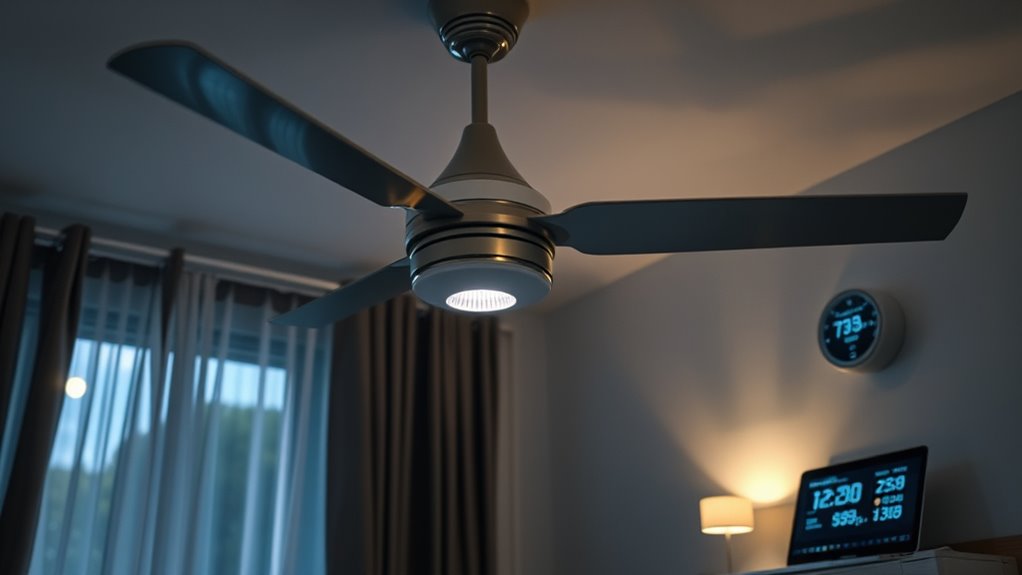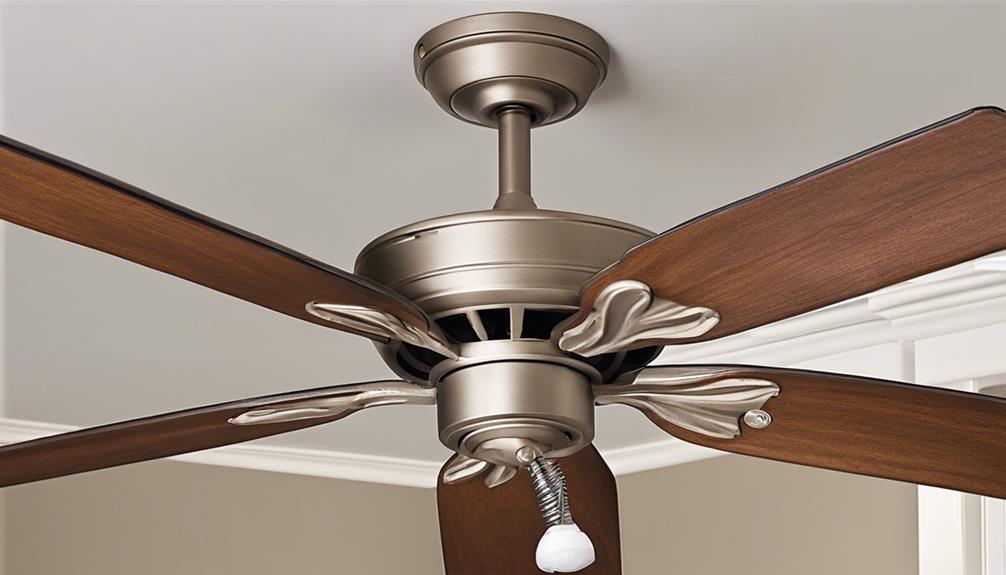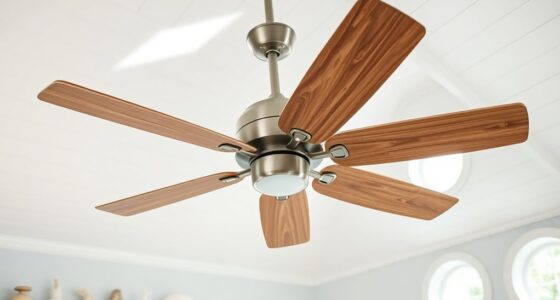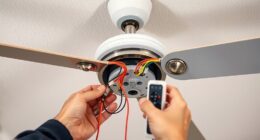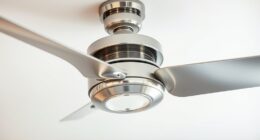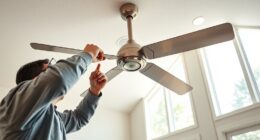To measure the true energy cost of overnight fan use, start by using a power meter or energy monitor connected to your fan’s outlet to track its wattage and consumption over several hours. Record the data, then multiply the wattage by the hours of operation to find total energy use in kilowatt-hours (kWh). Comparing these numbers helps you understand costs and environmental impact. Continue exploring to learn simple tips for reducing energy and saving money.
Key Takeaways
- Use a power meter to measure the fan’s real-time energy consumption during overnight operation.
- Record the fan’s wattage and hours of use to calculate total energy used in kilowatt-hours (kWh).
- Convert measured watt-hours to kWh and multiply by your local electricity rate for accurate cost estimation.
- Monitor noise and airflow patterns to identify inefficiencies that may increase energy consumption.
- Compare data over multiple nights to assess consistent energy costs and optimize usage for savings.
Understanding Fan Power Consumption
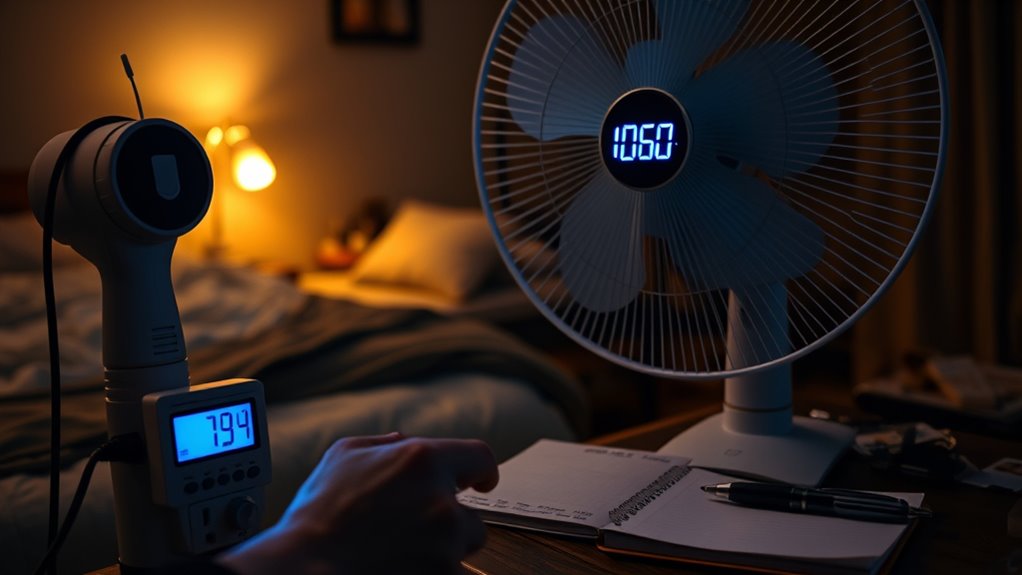
To understand the true energy cost of overnight fan use, it is crucial to know how much power your fan consumes. Fan efficiency varies depending on design and motor quality, affecting overall energy use. Check the fan’s power ratings, usually listed on the label or in the manual, to determine its wattage. A higher wattage indicates more energy consumption, especially if the fan runs all night. Some fans are designed with energy-efficient features that reduce power use without sacrificing performance. Knowing the power ratings helps you estimate daily energy costs accurately. To minimize energy waste, consider choosing fans with higher efficiency ratings. Being aware of your fan’s power consumption empowers you to make smarter decisions about usage, saving money and reducing your environmental impact. Additionally, energy-efficient features like variable speed motors can further optimize performance and reduce consumption. AI security measures can also be relevant here, as energy-efficient fans often incorporate smarter technology to optimize performance.
Tools Needed to Measure Energy Use
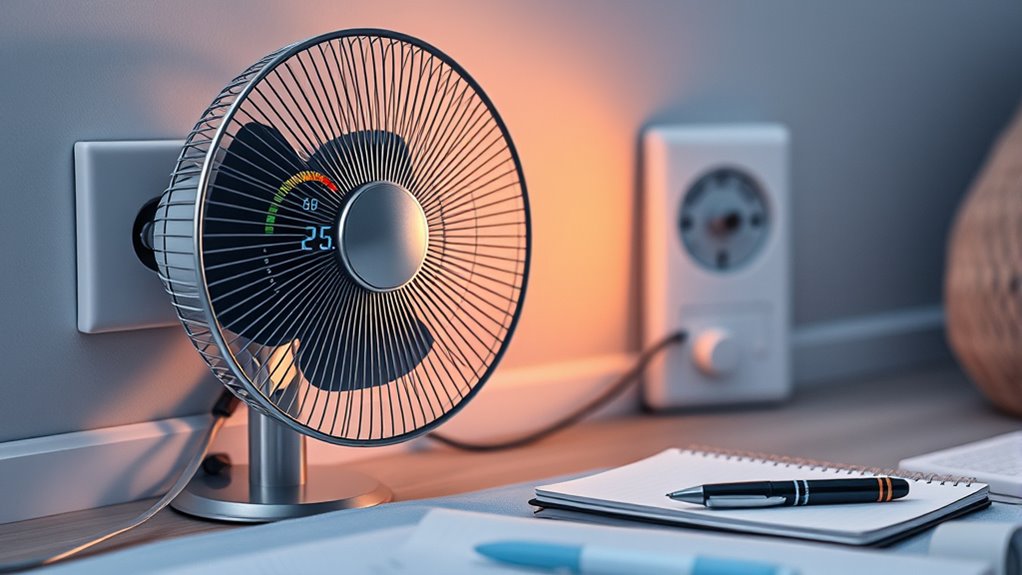
To accurately measure your fan’s energy use, you’ll need the right tools for monitoring consumption. Choosing the right device and understanding how to interpret the data are key steps in this process. Let’s explore the essential tools and tips to help you get precise energy readings. Using a power meter designed for household appliances can provide detailed insights into your fan’s energy consumption, ensuring you have accurate data to assess its true energy cost. Additionally, understanding the difference between energy units can help you better interpret the readings from your measuring devices. Being aware of Volkswagen Tuning concepts can also remind you of the importance of precise adjustments, whether in engine tuning or energy measurement.
Tools for Monitoring Consumption
When you want to accurately measure the energy consumption of your overnight fan, having the right tools is essential. A watt-meter or energy monitor allows you to track real-time power usage directly from the outlet, giving precise data on how much energy your fan consumes. These devices are simple to use and provide detailed insights, helping you identify inefficiencies. Regular fan maintenance, like cleaning blades and checking for proper operation, can improve performance and noise reduction, which also impacts energy efficiency. By monitoring your fan’s consumption closely, you can make informed decisions about usage patterns. The right tools help you understand both energy costs and maintenance needs, ensuring your fan runs smoothly and efficiently overnight. Additionally, monitoring air quality indicators can help determine if your fan is effectively improving air conditions. Understanding energy-efficient practices can further optimize your fan’s operation and reduce overall power consumption. Implementing power management techniques can maximize efficiency and prolong the lifespan of your fan.
Device Selection Tips
Choosing the right device to measure your fan’s energy use is essential for accurate results. First, consider your fan size—larger fans may require more robust meters capable of handling higher power levels. For smaller fans, a simple plug-in power meter works well. Next, pay attention to fan placement; ensure the device can be easily connected without obstruction, especially if the fan is in a hard-to-reach spot or mounted high. Look for meters that display real-time energy consumption and are compatible with your outlet type. Portable, user-friendly models are ideal for quick measurements, while more advanced tools suit detailed analysis. By selecting a device suited to your fan size and placement, you’ll obtain precise data to assess energy costs effectively. Additionally, understanding how automation in industry is advancing can help you choose more efficient devices that leverage current technological innovations. Recognizing energy measurement techniques can further enhance the accuracy of your readings, especially as smart appliances become more prevalent.
Interpreting Energy Data
Understanding the energy data your measuring device provides is essential for evaluating your fan’s true energy costs. When interpreting this data, focus on fan efficiency, which indicates how well your fan converts electrical energy into airflow. Look for patterns in power consumption over time to identify if the fan is operating efficiently or wasting energy. Energy labeling, such as ENERGY STAR ratings, can help you compare models and understand expected efficiency levels. Keep in mind that higher efficiency fans often cost more upfront but save money over time. By analyzing real-time energy use alongside manufacturer labels, you gain a clearer picture of your fan’s actual performance and long-term costs, enabling smarter decisions about overnight use and potential upgrades.
Setting Up Your Measurement Device
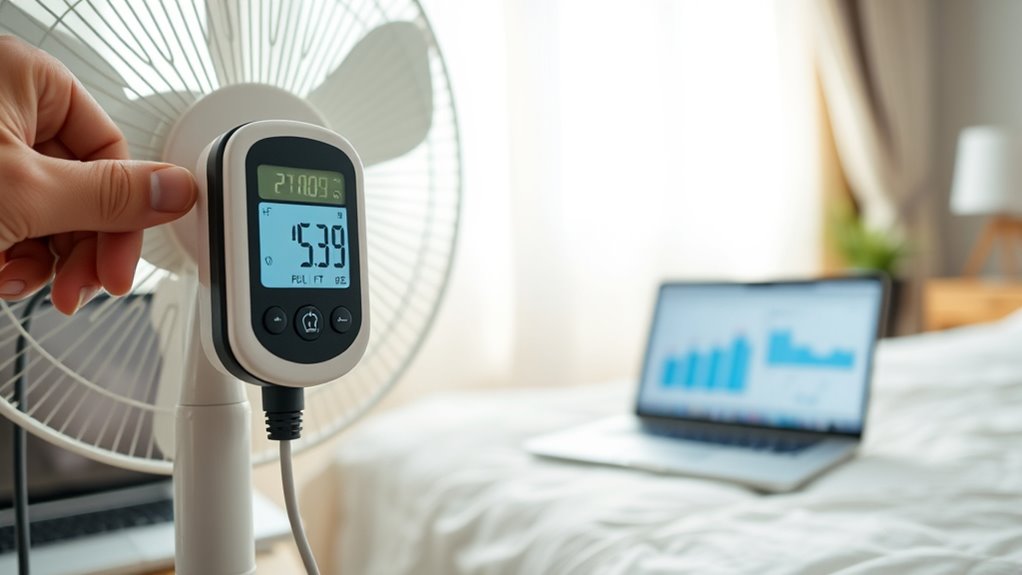
To accurately gauge the energy consumption of your overnight fan, you need to set up your measurement device correctly. Make certain the device is plugged in directly to the power source and connected securely to your fan. Position the fan in a typical operating environment to reflect real airflow efficiency. Keep the fan’s blade velocity consistent by avoiding unnecessary adjustments during measurement. Use a clamp meter or power monitor capable of recording real-time data for precise readings. Consider using a digital power monitor to enhance measurement accuracy and ease of data collection. Verify the measurement device’s calibration for accurate data collection. Position sensors to minimize airflow disturbance and capture true airflow efficiency. Document environmental conditions that might influence fan performance and energy use. Be aware that Louisiana alimony laws can impact the overall financial considerations related to your household expenses.
Recording Fan Usage Over Night Hours
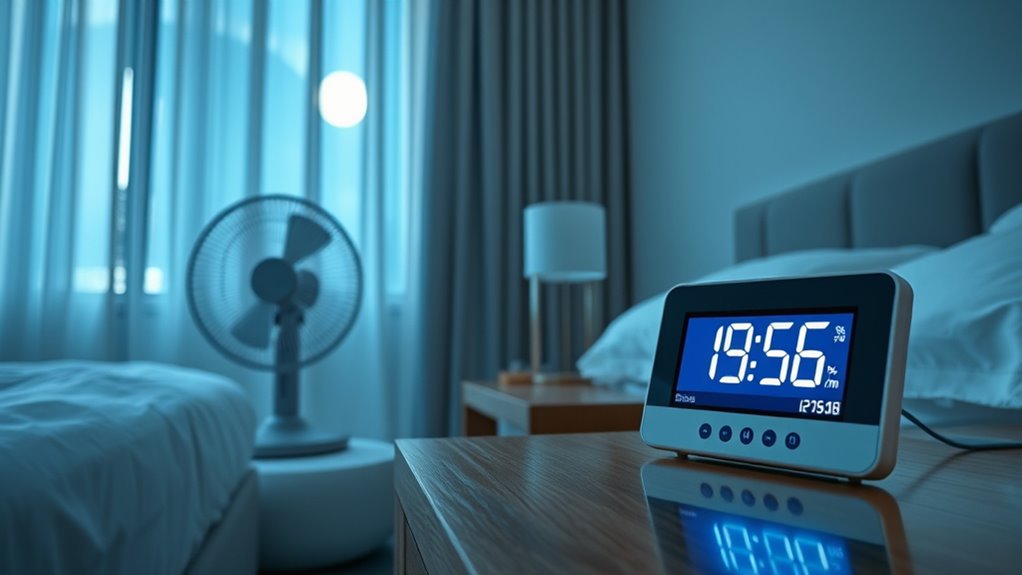
Start by tracking your fan’s power consumption during overnight hours to see when it’s actively running. Create a clear timeline of usage to understand patterns and identify peak times. Analyzing this data helps you evaluate the true energy impact of your fan use overnight. Incorporating knowledge about energy-efficient practices can further optimize your electricity consumption. Additionally, understanding how spiritual energy influences your overall well-being may motivate mindful energy conservation habits that align with your holistic health. Recognizing energy costs associated with different appliances supports more sustainable and cost-effective choices.
Monitoring Power Consumption Patterns
Tracking how your fan consumes power overnight provides valuable insights into its true energy cost. By monitoring usage patterns, you can identify periods of high energy draw and evaluate fan efficiency. This helps determine whether the fan operates effectively or consumes excess power due to inefficiencies. This process can also reveal potential energy waste, enabling you to take corrective actions to improve overall efficiency. Pay attention to noise levels, as louder operation may indicate motor strain or poor maintenance, affecting both performance and energy consumption. To gather accurate data, consider using smart meters or energy monitoring devices that record real-time power usage. Regularly checking for changes in performance allows you to detect potential issues early and address them promptly. Analyzing this information allows you to optimize fan operation, reduce unnecessary energy waste, and improve overall efficiency. Regular monitoring ensures you’re making informed decisions about your fan’s energy consumption and maintaining ideal noise levels for comfort. Understanding energy monitoring techniques can further enhance your ability to manage power use effectively.
Establishing Usage Timelines
Recording your fan’s usage over the night hours helps you identify exactly when and how long it runs, revealing patterns that impact energy consumption. By establishing clear usage timelines, you can maximize fan efficiency and maximize energy savings. Track start and stop times to see if the fan runs unnecessarily or during cooler periods. Use this data to adjust fan operation for better efficiency and lower costs. Consider creating a simple table like this:
| Time Period | Fan On/Off Status |
|---|---|
| 10:00 PM | On |
| 2:00 AM | Off |
| 4:00 AM | On |
| 6:00 AM | Off |
This helps you spot irregularities and adjust your schedule accordingly, ensuring your fan runs only when needed for maximum energy savings. Recognizing energy consumption patterns can further optimize your fan’s operation and reduce utility bills. Monitoring your fan’s operation with smart devices or energy meters can provide more detailed insights and enhance your efficiency strategies.
Analyzing Energy Impact
By analyzing the data you’ve collected on your fan’s on and off times, you can determine how much energy it consumes during different periods of the night. Pay attention to variations in fan speed, as higher speeds typically increase energy use. Monitoring noise levels can also help you identify when the fan runs at peak performance, correlating with higher energy consumption. Consider these key points:
- Adjusting fan speed settings to optimize energy efficiency
- Recognizing noise level patterns that indicate high or low usage
- Comparing energy costs during different fan speeds and noise levels
This analysis helps you understand the true energy impact of overnight fan use, enabling better decisions on when and how to operate your fan for cost savings.
Calculating Total Energy Consumption
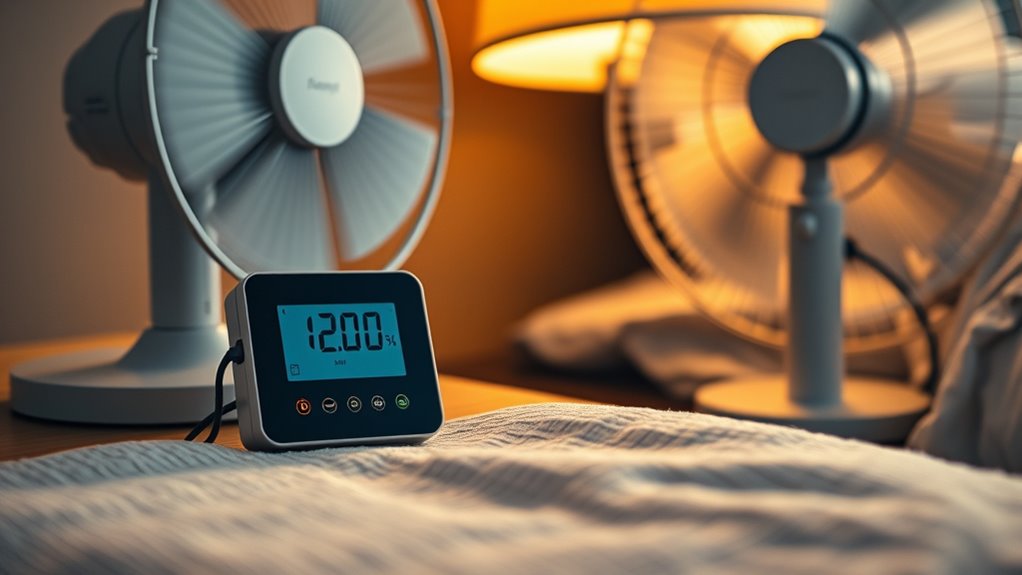
To accurately determine the total energy consumption of your overnight fan, you need to understand how to calculate the power usage over time. Start by checking the fan’s wattage rating, which indicates its power efficiency. Multiply this wattage by the number of hours you run the fan each night to find the total energy used in watt-hours. Converting watt-hours to kilowatt-hours (kWh) makes it easier for cost calculations and energy tracking. Focusing on fan efficiency helps you identify models that use less power for the same performance, improving energy optimization. By accurately calculating your fan’s total energy consumption, you can make informed decisions on usage patterns, reduce waste, and optimize energy savings without sacrificing comfort.
Comparing Costs and Environmental Impact
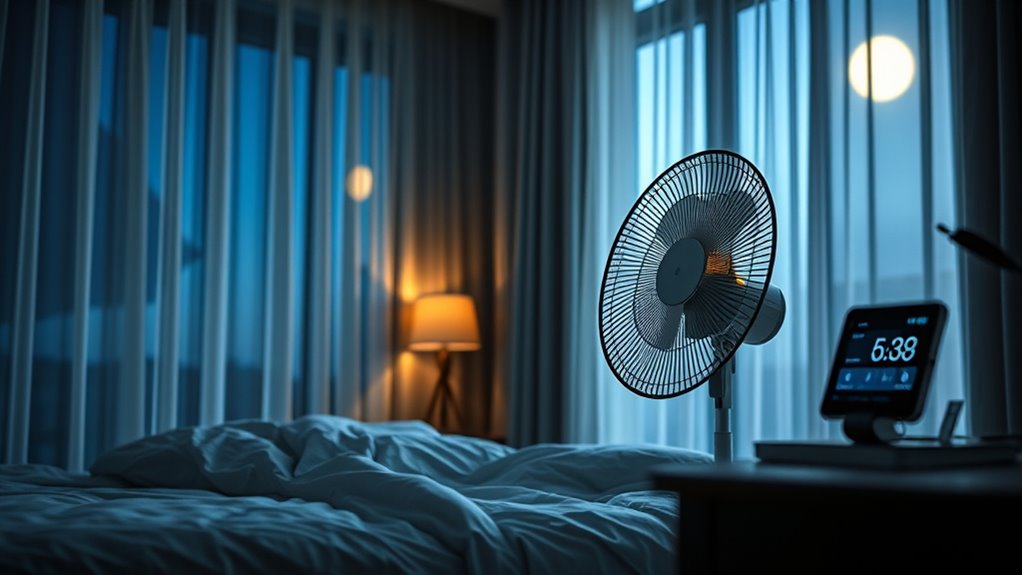
Understanding the costs and environmental impact of overnight fan use helps you make smarter choices. By comparing energy expenses and ecological effects, you can identify opportunities for improvement. Switching to renewable alternatives, like solar-powered fans, reduces reliance on fossil fuels and minimizes carbon footprints. Additionally, implementing energy-efficient upgrades—such as high-efficiency motors or smart timers—can drastically lower electricity bills and environmental harm. Consider the following:
- Moving to renewable alternatives to cut long-term costs and emissions
- Upgrading to energy-efficient fans for better performance and lower energy use
- Evaluating the environmental footprint of your current fan setup versus alternatives
Making informed comparisons empowers you to choose solutions that balance cost savings with sustainability.
Tips to Reduce Energy Use and Save Money
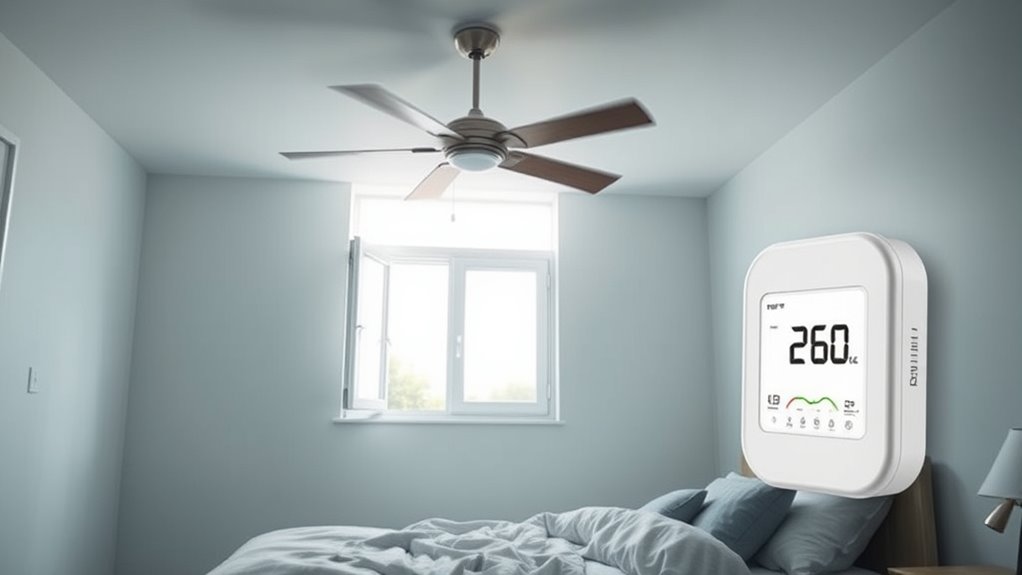
Reducing energy use from your overnight fan can lead to significant savings on your electricity bill. To boost fan efficiency, make sure your fan is well-maintained—clean filters and blades improve airflow and reduce unnecessary energy consumption. Consider switching to a more energy-efficient model with a higher power-saving rating, which consumes less power for the same airflow. Adjust the fan’s speed settings; running it on a lower setting can cut energy use without sacrificing comfort. Use timers or smart plugs to turn the fan off when it’s no longer needed, avoiding wasteful overnight operation. By focusing on fan efficiency and adopting power-saving habits, you can enjoy a cooler bedroom while saving money and reducing your environmental impact.
Frequently Asked Questions
How Does Fan Type Affect Energy Consumption?
Different fan types affect energy consumption based on their fan motor and blade design. For instance, box fans have larger motors and blades, using more energy, while oscillating fans often feature more efficient motors and aerodynamically designed blades. You’ll find that energy-efficient fan motors and innovative blade design help reduce power use, making some fans better suited for overnight use. Choosing the right fan type can save you significant energy costs over time.
Are There Specific Features That Optimize Energy Efficiency?
To optimize your fan’s energy efficiency, look for features like eco-friendly materials that reduce environmental impact and noise reduction technology for quieter operation. These features help you save energy while maintaining comfort. Choosing fans with efficient motors and adjustable speed settings also makes a difference. By prioritizing these features, you guarantee your fan runs efficiently, minimizes energy waste, and creates a more comfortable, eco-conscious environment overnight.
What Is the Typical Energy Cost Difference Between Fan Models?
Imagine a quiet room, where your fan hums gently, but you wonder how much energy it’s truly costing. The typical energy difference between fan models varies, often influenced by fan maintenance and noise levels. Higher-efficiency models use less power, saving you money over time, while noisier, older fans might consume more energy. Keeping your fan well-maintained guarantees peak performance, reducing unnecessary energy use and keeping noise levels low.
How Often Should I Measure Fan Energy Use for Accuracy?
To guarantee accurate understanding of your fan’s power usage, you should measure its energy use regularly. Ideally, check the measurement frequency weekly or biweekly, especially if you notice changes in performance or electricity bills. Frequent measurement helps identify patterns and ensures your fan isn’t consuming more energy than expected. Staying consistent with these checks allows you to track true energy costs effectively and make informed decisions about your fan’s operation.
Can Smart Plugs Provide More Precise Energy Measurements?
Like a vigilant sentinel guarding a treasure, smart plugs offer precise energy monitoring for your fan. They track power consumption accurately, revealing hidden costs you might miss otherwise. With real-time data, you can make smarter decisions about usage, saving energy and money. So, yes, smart plugs provide more precise measurements, turning the mystery of energy consumption into clear insights, helping you optimize your fan’s efficiency effortlessly.
Conclusion
By measuring your fan’s energy use, you’re shining a flashlight into the dark corners of your energy bill, revealing hidden costs. Think of it as tuning a guitar—small adjustments can create a sweeter, more harmonious savings melody. When you understand and reduce your fan’s true energy cost, you’re steering your home’s power like a captain steering through calm waters. Every watt saved is a ripple, quietly making your world a little greener and your wallet a little heavier.
